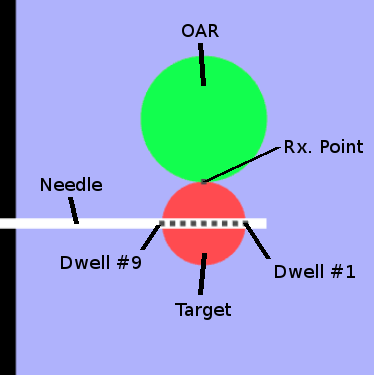Brachy 2D
Learn about high-dose rate (HDR) brachytherapy by planning simple treatments.
Shape:
Radius/Height: 2 |
OAR: Organ at risk (green)
Radius: 3 | Position: (-3, 5)
Rx. Dose:
Dwell Weights:
Isodose Lines/Colors
300% (1200 cGy)
200% (800 cGy)
100% (400 cGy)
80% (320 cGy)
60% (240 cGy)
40% (160 cGy)
20% (80 cGy)
Target (red)
OAR (green)
Dose Stats (cGy)
Max. Target Dose: 0.00
Min. Target Dose: 0.00
Max. OAR Dose: 0.00
Dwell Times (seconds)
1) 0.0
2) 0.0
3) 0.0
4) 0.0
5) 0.0
6) 0.0
7) 0.0
8) 0.0
9) 0.0
About Brachy 2D

Brachy 2D is a web app designed to teach basic concepts about HDR brachytherapy planning by providing a simple, adjustable test case. In this case disease (the target) is being treated with one interstitial needle that has nine dwell positions for the HDR source to dwell in. There is a nearby organ at risk (OAR) that should receive as little radiation as possible. Both the target and OAR can be altered to produce different treatment scenarios. The dose to be delivered (Rx. Dose) is prescribed to a point (Rx. Point). Please use the diagram on the left for reference to the above terms.
During the planning process, you can set the radiation prescription dose point and location. Also, the weights for each dwell position can be manually adjusted; the higher the weight, the longer time the source will dwell in that position. The weights are all relative. The radiation dose is calculated according to the AAPM TG-43 formalism, using the BrachyDose43 C++ code found here on this site. The modeled source is a microSelectron-v2 Iridium-192 HDR source. Here are some related links for reference and further reading: